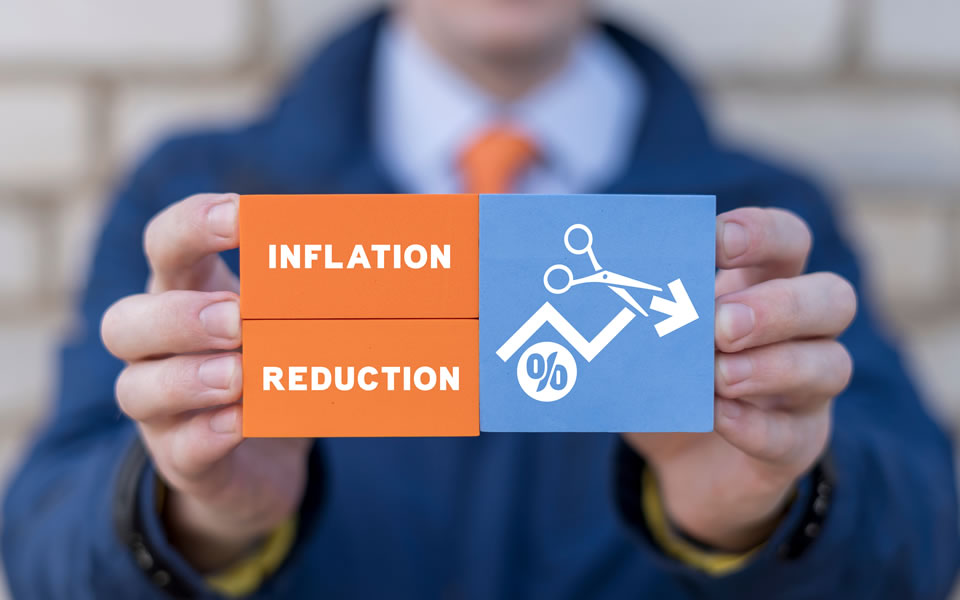From Tax Credits to Jobs: The Inflation Reduction Act’s First-Year Impact
By Peter Downing, National Principal-in-Charge, Tax Credits & Incentives
The Inflation Reduction Act (“IRA”) was passed on August 16, 2022 and signed into law by President Biden. This historic piece of legislation is aimed at fighting the Climate Crisis by making significant investments in clean energy never seen before. The Congressional Budget Office officially scored the bill to cost some $369 billion over the next decade. However, Goldman Sachs puts the number close to $1.2 trillion.
Included in the IRA was the expansion or creation of 22 tax credits for green energy production, zero-carbon energy production, electric vehicles and charging stations, residential clean energy, advanced manufacturing, and alternative fuels. These tax credits have two goals: increasing the development of low or zero-emission technologies and strengthening the US economy by creating clean energy jobs from manufacturing these technologies and long-term construction jobs.
Since its passage, more than 200 large utility-scale US clean energy projects have been announced, creating more than 70,000 jobs. The American Clean Power Association estimates the Inflation Reduction Act has led to the deployment of more than 180,000 megawatts of utility-scale clean energy projects, resulting in $4.5 billion in customer savings. They also suggest that the IRA could lower US emissions by as much as 48% by 2035.
Clean Energy Credits
Five main tax credits in the Clean Energy Production space now have a 10-year runway. Before the IRA was passed, many of these tax credits had to be extended by Congress every year. Large utility-scale developers had to operate with this uncertainty of when the tax credits would be available. The longer availability will stabilize the Clean Energy Marketplace as large utility-scale projects can take several years to plan, construct, and complete.
The new tax credits have also created complexities, including the “bonus” tax credits, which can increase the overall Investment Tax Credit to 70% if a project checks all the boxes. A 10% “bonus” credit is available if a clean energy project 1) meets domestic production content, 2) is located in a former energy community (former coal or oil site), EPA brownfield, or low-income area, or located on tribal lands. We are seeing many projects generating a 40% Investment Tax Credit in 2023 and some 50% ITC deals for 2024. Projects under 1 megawatt of production, which is most Commercial and Industrial projects, are grandfathered in at the 30% ITC rate. Projects over 1 megawatt of production must meet certain labor and apprenticeship standards by using either union labor or paying prevailing wages. If a developer does not satisfy this requirement, the ITC drops to 6%.
Another provision of the IRA also includes a “Transferability” provision in which Investment Tax Credits can be transferred to another taxpayer. Typically, a developer does not have the tax capacity to claim its own Investment Tax Credits. Before the IRA, developers would sell projects to another taxpayer or enter into a tax equity transaction with a large commercial bank or insurance company. Now, with the IRA, the developer can technically “transfer” the ITC to another taxpayer (Typically a large C Corporation) and retain ownership of the clean energy project for themselves.
Another key provision of the IRA was the creation of a “Direct Pay” option for certain taxpayers (mainly non-profits and other tax-exempt entities such as state and local governments) that can claim the Investment Tax Credit, which becomes refundable at the entity level. These provisions will allow certain taxpayers that previously could not claim the government incentives to now claim them through a “refundable” tax credit on the tax return once it is filed.
The IRS has been very busy issuing guidance on many portions of the Inflation Reduction Act over the past year. In November 2022, the IRS published guidance on the wage and apprenticeship requirements affecting projects over 1 megawatt of production. In February 2023, the IRS published guidance on the energy community and low-income community bonus credits. In May 2023, the IRS issued guidance on domestic content bonus credits. Furthermore, in June 2023, the IRS published initial guidance on the transferability of the ITC, with more guidance coming later this year.
Electric Vehicle Credits
Also included in the IRA was the expansion and creation of 9 tax credits for electric vehicles. Most of the subsidies aim to reduce emissions from road travel, predominately by subsidizing electric vehicles (EVs) and EV infrastructure. Tax credits are also available for alternative fuels like biodiesel and hydrogen technology.
However, claiming and utilizing the EV credits has been challenging over the past year. First, there is an income limitation to using the EV credits ($300,000 MFJ and $150,000 single taxpayer). If you can clear the income hurdle, the $7,500 EV credit may not be fully available to you. In December 2022, the IRS issued guidance forcing auto manufacturers to source critical components such as minerals and battery components from US sources or countries where the US has a fair-trade agreement to meet certain domestic requirements to be eligible for the full $7,500 tax credit. The ITC is cut to 50% or $3,750 if a manufacturer fails this domestic requirement test. The IRS has published a list of eligible makes and models that qualify for the full $7,500 EV credit.
Residential and Commercial Incentives
The IRA has something in it for everyone. Effective 1/1/23, two tax credits are focused on homeowners. The non-business energy credit (Section 25D) creates a 30% tax credit for installing solar panels, geothermal heat pumps, and small wind turbines. The second credit is the energy efficiency improvement credit (Section 25C), which creates a 30% tax credit for various home improvement projects such as windows and doors, electric furnaces or heat pumps, insulation, and electric appliances. The annual cap on this credit is $1,200.
Commercial building owners and multi-family owners also are benefiting from the Inflation Reduction Act. The IRA expanded the Section 179D deduction by significantly increasing the deduction per square foot for qualified improvements made to the commercial building. Owners of new multi-family buildings can qualify for an expanded Section 45L credit for meeting energy efficiency standards under the IRA.
The Progress and Hurdles of the IRA’s First Year
One year after its inception, the Inflation Reduction Act (IRA) has left a tangible imprint on the U.S. clean energy landscape. Through the introduction and expansion of 22 tax credits, the IRA has catalyzed the launch of over 200 major clean energy projects, created 70,000 jobs, and potentially set the nation on a course to slash emissions by nearly half by 2035. While the legislation has undeniably accelerated the country’s transition to a greener future, it hasn’t been without challenges, especially in the electric vehicle sector, where tax credit eligibility complexities persist. Nonetheless, from utility giants to homeowners, the IRA has broadened opportunities for a more sustainable, energy-efficient future. The upcoming years will be crucial in determining if the momentum generated by the IRA continues and if the U.S. can successfully meet its ambitious environmental goals.







